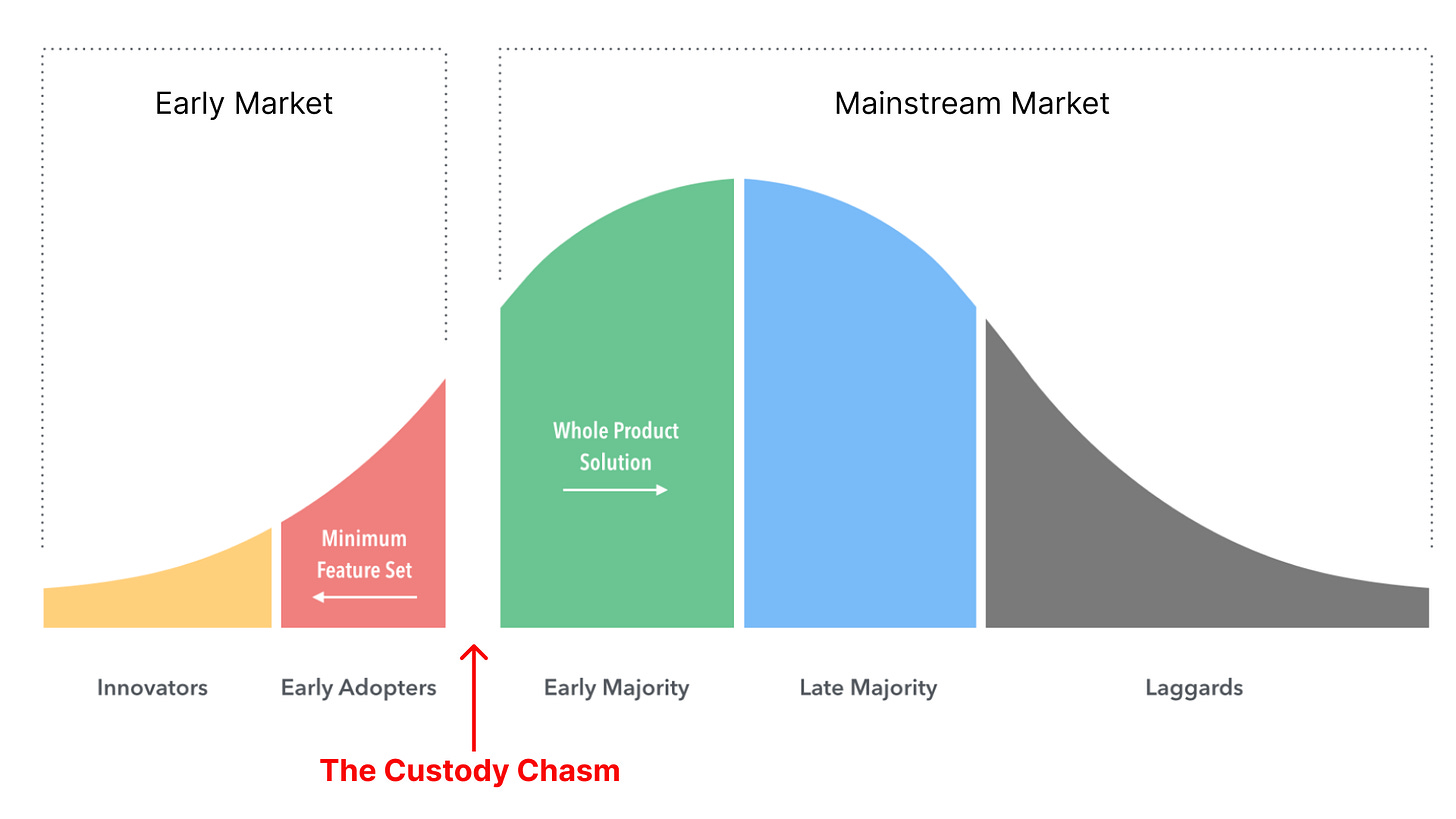The Custody Chasm
Appeal to mainstream customers without losing early adopters (of NFTs)
If you're a company selling NFTs today, you're stuck in a pickle. There are dozens if not hundreds of companies clamoring for a small population of NFT buyers who are spending less than they used to: trade volumes are 1/10th of a year ago. On more occasions than I’d like to admit, I've endured the disappointment of not reaching sales goals even though we did all the right things.
The alternative path is to appeal to newer or first-time NFT buyers. The pickle is that these new buyers are different from the existing ones; they have different demands for what they find valuable. The core of this is the Custody Chasm.
All customers fall somewhere on this spectrum.
Early Market Earl is on the left side of the chasm. He works at a tech startup and bought his first bitcoin in 2017. He owns a Ledger self-custody wallet where he holds 17 different NFTs, two of which are worth over $5,000. He’s skeptical of Big Tech and excited for the promise of a more open web3.
Mainstream Maddie is on the right side. She's an executive at a media company who loves listening to Lizzo and watched every episode of House of the Dragon. She bought her first NFT recently, the Game Of Thrones one, through a website Nifty's where she could use a credit card. She thinks it’s cool, but isn't sure what to do with it.
The Custody Chasm is the technical barrier inhibiting companies from appealing to both Earl and Maddie.
Earl demands a self-custody option where he can hold the NFT in his Ledger wallet. He wants to be able to trade the asset on a third-party marketplace like OpenSea and retain ownership even if the issuing company goes out of business. He has no problem connecting his Ledger wallet to do in-app interactions.
On the other hand, Maddie appreciated that she could buy the GoT NFT with a credit card and email address. She has no desire to learn about Ledger wallets and crypto exchanges. Nifty's uses an app-custody model where they do the on-chain activity behind the scenes; they link your email to a blockchain wallet that they create for you. This opens the door to offer mainstream experiences that she is familiar with. The trade-off is that Nifty's controls her assets; she can only do what they allow. Earl thinks this defeats the whole promise of true ownership in web3.
How can we attract Maddie without alienating Earl?
What if there was a hybrid custody model that allowed both a self-custody wallet and app-custody wallet to access the single account holding an asset? The app could provide mainstream UX — credit cards, email signup, and avoid external wallet signing — and the self-custody wallet could interact with 3rd party marketplaces.
This is the recent proposal from the Flow blockchain team. It works like a joint custody bank account; two parties can have access. It’s still early in its implementation, so we’ll see how it gets adopted, but it looks to be a way to solve this chasm problem.
Flow Chief Architect Dieter Shirley described it this way: "A new user, without a self-custody account, can sign up for a new account without having any wallet software. But when they are ready for self custody, they can delegate control of the app-custody account to their self-custody account."
It would look something like this:
Flow Product Manager Chris Ackermann summarized the benefits:
Full user control of their assets in both their self-custody wallet and in-app account, while the app can continue to use the assets in the context of the app without an interrupted user experience through transaction approvals.
The option for users to bring their assets with them elsewhere in the ecosystem of Web3 apps, while retaining the ability to seamlessly use them within the app.
App visibility into assets that the user holds in their self-custody wallet, and the ability to request temporary access for use within the app, if it makes sense to do so.
I’ll also underscore a problem I’ve faced across multiple companies where my team dropped NFTs before our marketplace was ready. We used an app-custody model so transactions were impossible for users. In the hybrid scenario, the user could trade from day 1—through a 3rd party marketplace— while the app builds out their own.
It looks like someday soon Maddie and Earl will be able to enjoy the same NFTs. Companies will welcome customers from both sides of the chasm. And we'll all be able to buy, to hold, and to loiter in Discords as projects take-off together.





Well thought out messaging here, this is indeed one of the big rocks to move in web3.